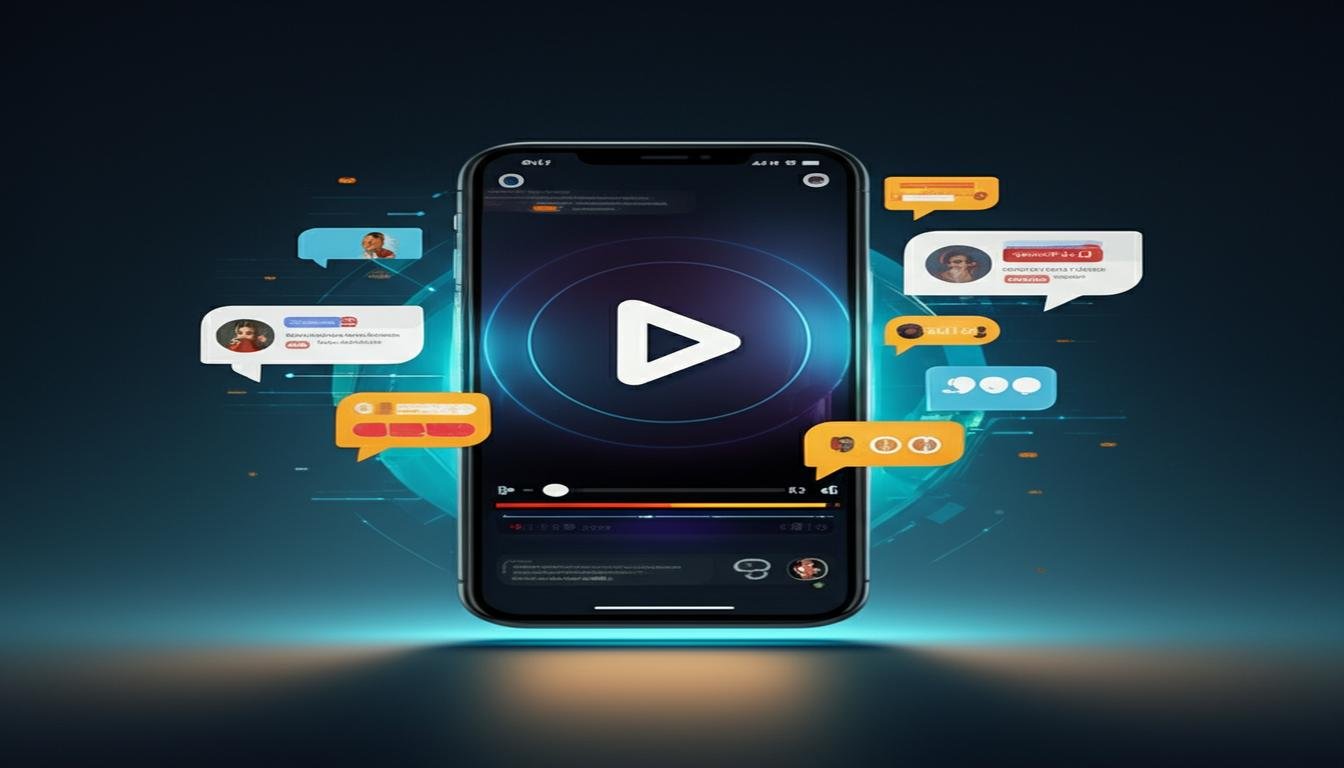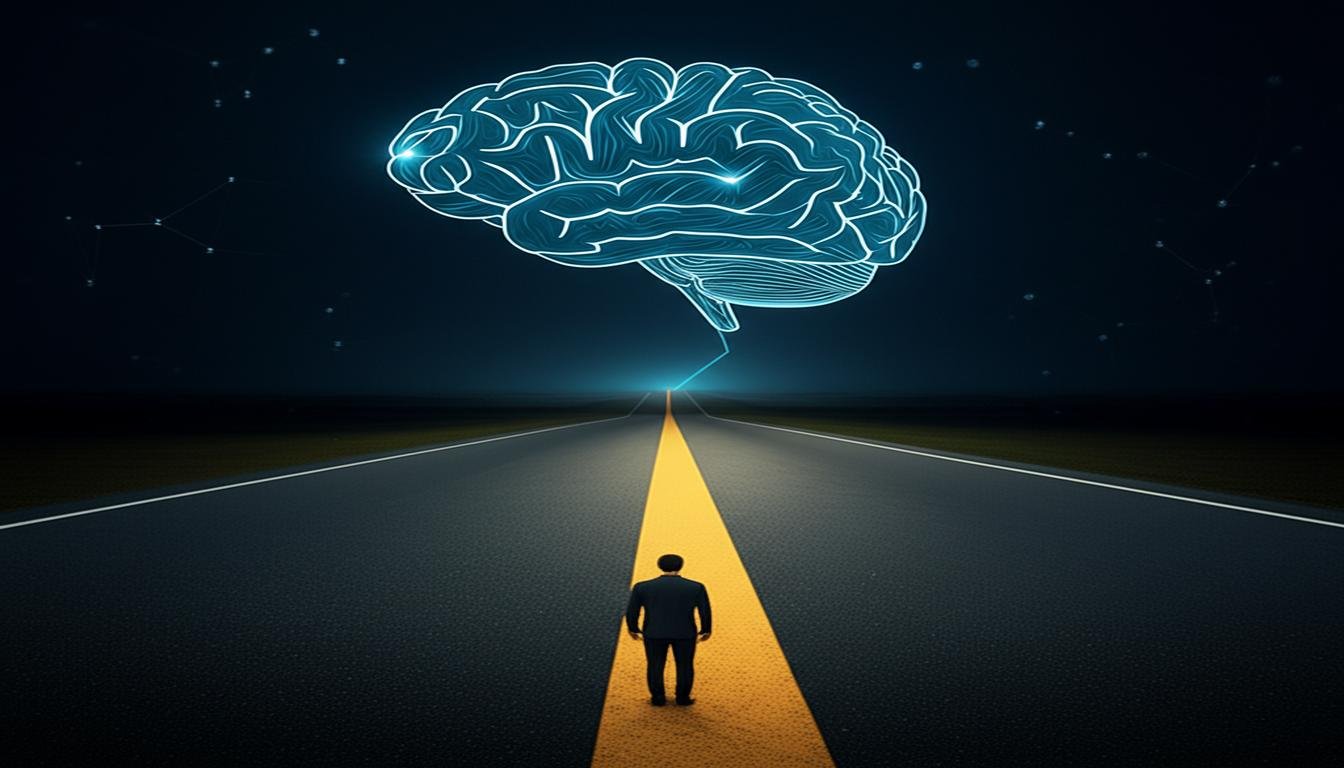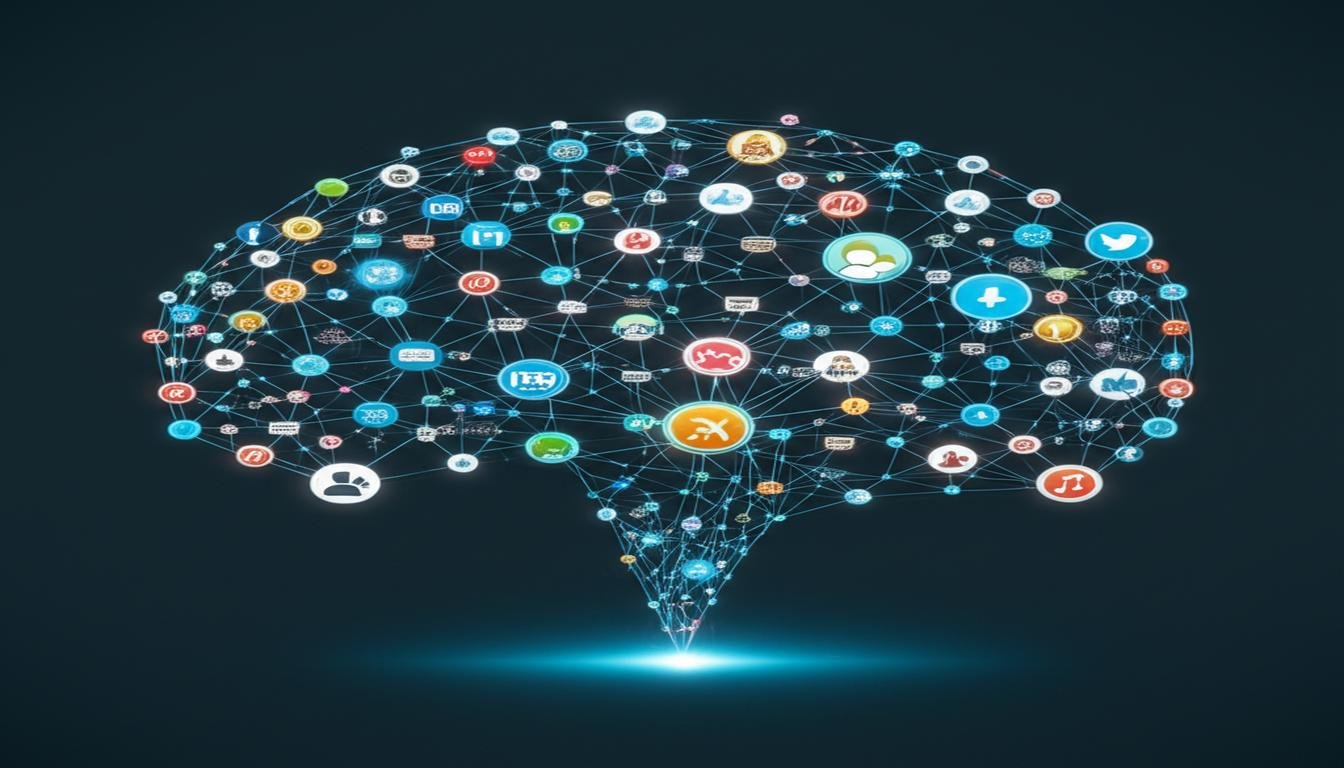Imagine if machines could think better than us in ways we can’t even dream of. This idea is at the center of today’s talks about artificial intelligence. Computers are great at numbers and patterns, but they can’t match our creativity and feelings. Let’s dive into what “intelligence” really means today.
IBM says AI is about systems that learn and solve problems like us. But Alan Turing’s 1950 test, which checks if machines can talk like humans, is a big debate. Now, machines can even help doctors and make music.
The MIT Work of the Future Initiative points out a key difference. Computers can process data fast, but we understand things through culture, ethics, and feelings. Think of chess players who lost to Deep Blue. It wasn’t because they were bad, but the machine could think of millions of moves in seconds.
Key Takeaways
- AI is fast at data but lacks our intuition
- Our emotional intelligence is unique
- The Turing Test is a big part of AI’s history
- Working together with machines is key
- The future of AI needs ethics and creativity
As we look into this complex relationship, remember: intelligence is more than one thing. The future of AI is about working together, not competing. Let’s see where machines and brains meet – and why that’s important for all of us.
The Intelligence Showdown: Defining the Battlefield
The battle between artificial and human intelligence starts with how we measure smarts. Unlike chess or math contests, real-world smarts involve intuition, ethics, and creativity. Let’s explore what makes both biological and digital minds unique and where they differ.
What Constitutes “Smart” in Machines?
Modern artificial intelligence excels in three main areas:
- Pattern recognition: Systems like IBM Watson analyze millions of oncology papers in seconds
- Precision tasks: Industrial robots achieve 0.02mm accuracy consistently
- Data synthesis: Machine learning models process datasets no human could digest
But there are limits. Robotics pioneer Hans Moravec noted: “Computers need explicit programming for what humans do unconsciously.” This highlights why AI is great at complex calculations but struggles with simple human skills like sarcasm.
Human Cognition Fundamentals
Our brains work in unique ways. While machines process data, humans:
- Interpret context during medical diagnoses
- Adjust strategies mid-conversation
- Make ethical judgments with incomplete information
MIT’s neural network research shows why. Human thinking combines:
| Component | Machine Equivalent | Human Advantage |
|---|---|---|
| Memory | Storage databases | Associative recall |
| Learning | Training datasets | Cross-domain adaptation |
This is why oncologists consider a patient’s lifestyle during treatment planning—something AI struggles to do. Our unique blend of logic and empathy makes us different.
Are Robots Smarter Than Humans? Breaking Down the Metrics
When we compare robot and human intelligence, we look at both numbers and the mind’s unseen parts. DARPA’s Machine Common Sense Framework helps us understand by checking 137 skills in four areas. This shows why some assembly lines now feature 90% robotic workers but humans lead in complex projects.
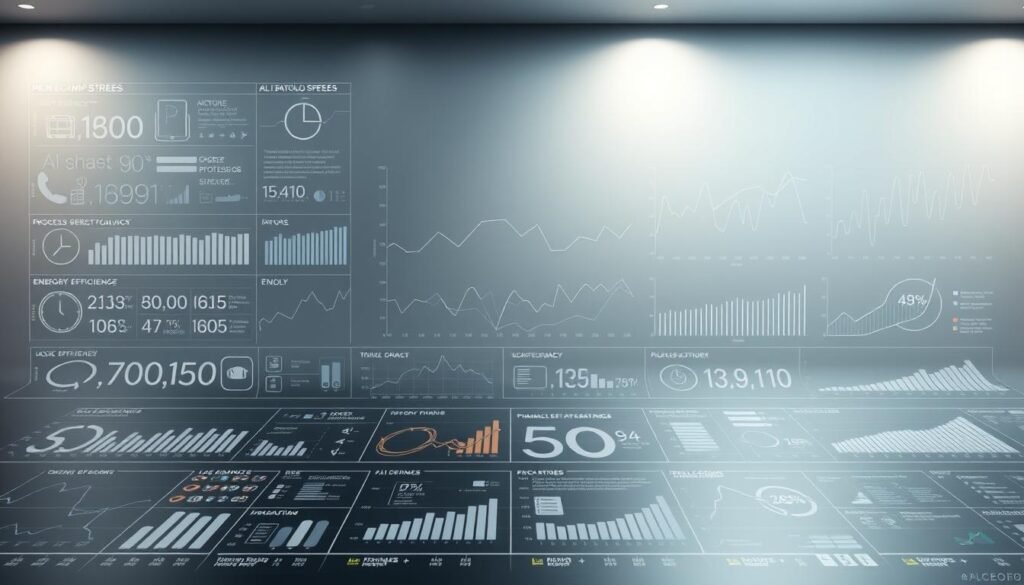
Quantitative Comparison Framework
Fanuc’s M-2000iA robots show huge numbers in controlled settings:
| Metric | Industrial Robot | Master Machinist | Advantage Ratio |
|---|---|---|---|
| Precision Operations/Hour | 12,400 | 83 | 149:1 |
| Microscopic Error Rate | 0.00017% | 0.4% | 235:1 |
| Continuous Operation | 168 hrs | 4.2 hrs | 40:1 |
But these numbers only tell part of the story. Source 3’s safety analysis shows:
“Robots reduce workplace injuries by 72% in repetitive tasks but contribute to 89% of system failure incidents requiring human intervention.”
Qualitative Intelligence Factors
Humans are best in unpredictable situations. HOOBOX Robotics used AI to read emotions in senior care:
- 94% accuracy in detecting basic emotions
- 0% capability to contextualize emotional triggers
- 72-second delay in appropriate response generation
NASA’s Mars Rover team shows human skills are unique. During the Perseverance landing:
- Engineers improvised 11 contingency plans in 7 minutes
- Cross-disciplinary teams synthesized atmospheric data in real-time
- Ethical decisions made about sample prioritization
This ability to adapt is hard for machine learning to match. AI is great at recognizing patterns in 28,000 data points at once. The real challenge is seeing the value in speed versus flexibility.
Case Study 1: Healthcare Diagnostics
Imagine a tool that reads 30 million medical papers in one night. That’s what IBM Watson does for cancer care today. This case study looks at how artificial intelligence changes diagnostics and shows where humans are needed.
IBM Watson Oncology Analysis
At MD Anderson Cancer Center, Watson matched patients to clinical trials 90% of the time. This is almost double what humans do. Watson’s cognitive computing lets it:
- Read 200 million pages in 15 seconds
- Compare patient histories with global guidelines
- Find rare biomarkers that humans miss
But Watson has its limits. At first, it had trouble with unclear symptoms that doctors understand better. A researcher said: “The AI sees data points – physicians see people.”
Human Oncologist Comparison
While Watson matches patients to trials 90% of the time, doctors do it 50% of the time. But doctors are better in three areas:
| Factor | AI System | Human Specialist |
|---|---|---|
| Emotional Intelligence | 0% | 100% |
| Data Processing Speed | 30M papers/hour | 10 papers/hour |
| Adaptability to New Scenarios | Requires reprogramming | Immediate adjustment |
Johns Hopkins’ 2023 study showed combining AI and human doctors works well:
- Diagnosis was 42% faster
- Treatment errors dropped by 35%
- 91% of patients were happy with AI help
This mix is key. As robotics get better in surgery, diagnostics show how cognitive computing helps, not replaces, human insight. It sets a new standard for medicine.
Case Study 2: Manufacturing Precision
Modern factories are where robots and machinists work together. This shows how machine learning and human skills mix in tough production settings.
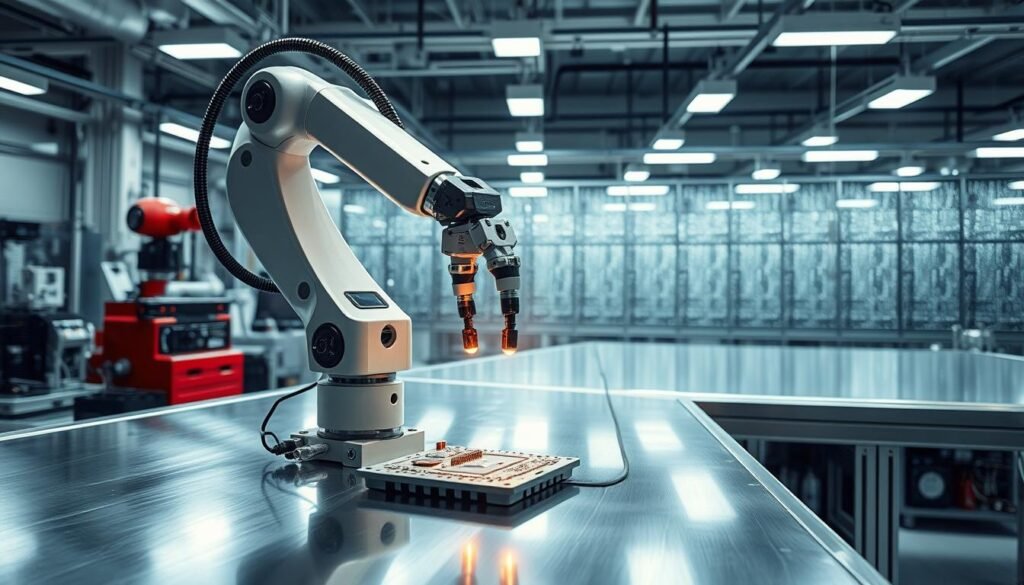
Fanuc Intelligent Robots
Fanuc’s CRX-10iA robot is super precise, with 0.02mm accuracy. These self-programming robots:
- Do 85% of welding tasks on their own
- Spot material changes with 3D vision
- Change workflows in real-time with neural networks
At Boeing’s South Carolina plant, these robotics help with 73% of aircraft frame welding. “The robots make perfect seams on curved parts,” says Carla Rodriguez. This lets technicians work on harder tasks.
Skilled Machinist Benchmarking
Humans are better in three key areas:
- Tactile adjustments: Machinists feel tool vibrations to avoid damage
- Blueprint interpretation: They turn unclear specs into real parts
- Quality intuition: They find small defects that sensors miss
“My hands sense when metal is stressed before gauges do,” says Dwight Harper, a 27-year machinist. “That 0.1mm tolerance? That’s our human judgment.”
Automation does most of the work, but humans do 92% of custom jobs. MIT’s study found teams with both humans and machines are 18% more productive than just machines.
The Department of Labor says 142,000 new robotics technician jobs have been created. This has helped replace 63% of assembly jobs. Now, there are programs to teach:
- AI maintenance
- Collaborative workflow design
- Quality assurance analytics
The Learning Curve: Machine vs Human
Learning processes show big differences between artificial intelligence and human skills. Machines are great at quick data processing. Humans, on the other hand, understand context better. Let’s look at two case studies that change how we see learning.
MIT’s Cheetah Robot Evolution
MIT’s quadruped robot learned complex movements through 10,000+ simulated falls over eight years. This evolutionary approach helped engineers:
- Test gait patterns in virtual environments
- Optimize energy efficiency by 43%
- Develop fall recovery algorithms
DARPA’s Lifelong Learning Machine metrics show the Cheetah achieves 98.7% task success after training. Yet, human trainers set its core objectives, showing a limit in autonomous goal-setting.
“Simulation-based learning lets robots fail safely, but real-world adaptability requires human-like sensory integration.”
Apprentice Electrician Training
IBEW’s four-year apprenticeship program combines classroom learning with 8,000+ hands-on hours. Siemens’ hybrid training system enhances this process through:
| Metric | MIT Cheetah | Electrician Program |
|---|---|---|
| Training Duration | 8 years (simulated) | 4 years (real-world) |
| Error Rate Reduction | 92% (Year 1-8) | 68% (Year 1-4) |
| Knowledge Transfer | Algorithm updates | Mentor relationships |
| Adaptability | Predefined scenarios | Novel problem-solving |
OSHA’s competency benchmarks require electricians to show situational judgment. AI mentors struggle to replicate this skill. AR simulations help apprentices practice high-risk scenarios, but final certifications demand live evaluations.
This contrast shows the future of AI in education. Hybrid systems are key, where machines handle repetitive tasks and humans focus on creative solutions. As Source 1’s learning capacity comparison shows, combining both approaches yields 31% better results than either method alone.
Current AI Limitations
Modern AI systems are amazing but also show big gaps in skills we learn by age three. This gap is at the core of Moravec’s Paradox. It says that doing complex thinking is easier than mastering basic motor skills, which took millions of years to develop.

When Backflips Beat Doorknobs
Boston Dynamics’ Atlas robot is a perfect example of this paradox. It can do parkour moves like an Olympic athlete but can’t even turn a door handle. There are three main reasons for this:
- Biological legacy: Humans developed motor control over thousands of years
- Data scarcity: AI systems don’t have the same early life experiences as humans
- Common sense gaps: Humans naturally understand basic physics, but machines don’t
Google’s Everyday Robot project also shows these challenges. Factory robots do great in controlled settings, but mobile robots struggle with:
- Unpredictable weather
- Cluttered spaces
- Complex social situations
Research from Source 2 explains why cognitive computing finds physical tasks hard. Human brains handle sensory data through special pathways developed over time. AI systems use digital simulations, leading to a big difference in dealing with real-world changes.
The issues go beyond just robotics. Language models can write great essays but struggle with:
- Understanding sarcasm
- Knowing when info is outdated
- Making ethical decisions
These challenges don’t mean AI has no value. They show how important it is to work together with humans. As Source 3’s study points out, combining AI technology with human insight makes systems that are fast and understand context. We’ll look into more about this in future discussions on hybrid intelligence.
Human Cognitive Advantages
AI is great at recognizing patterns and doing the same tasks over and over. But humans have unique skills that AI can’t match. These strengths are most visible in situations that are unpredictable, need creativity, and require working together. In these areas, human vs robot intelligence shows humans have big advantages.
NASA’s Mars Rover Team Coordination
In 2009, NASA’s Spirit rover got stuck in Martian soil. Engineers showed incredible human creativity. They had to come up with a plan, knowing it would take 150 million miles to get a response.
- They used dental floss simulations to test extraction methods
- Developed 12 contingency plans in 48 hours
- Applied Earth geology knowledge to Martian conditions
This was different from JPL’s AEGIS system, which follows set rules to choose targets. AEGIS is 60% faster than humans, but Duke University found humans do better in new situations by 38%.
| Problem-Solving Factor | Human Teams | AI Systems |
|---|---|---|
| Adaptability | Improvise with unrelated tools | Require pre-programmed solutions |
| Creative Insight | Analogous thinking (e.g., dental floss) | Pattern-based predictions |
| Error Correction | Real-time collaborative adjustments | Require retraining cycles |
The best thing about artificial intelligence and human intelligence working together is when humans use their understanding and AI uses its precision. As Source 1’s social intelligence analysis says: “Human teams turn obstacles into chances by sharing their experiences. This is something no algorithm can do.”
Hybrid Intelligence Systems
Imagine if humans and AI worked together instead of against each other. Hybrid intelligence systems do just that. They combine human creativity with AI’s precision. This new way of working is changing the future of AI.
Now, humans make big decisions, and AI handles the details. This teamwork is making a big difference.
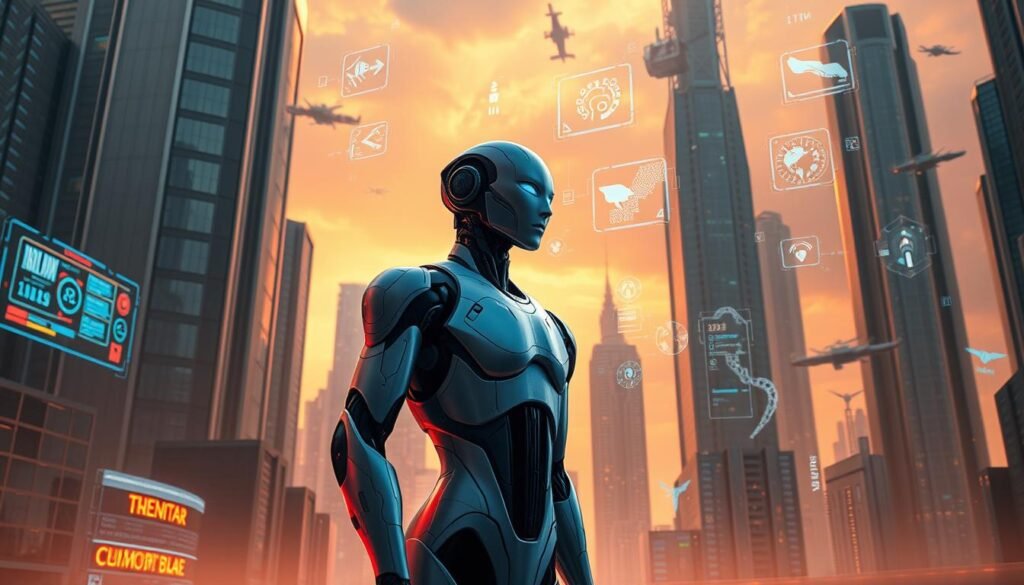
Lockheed Martin’s Pilot Associate
The F-35 fighter jet has an AI copilot. It works by analyzing 40+ sensor feeds at the same time. This helps pilots a lot.
- It reduces their workload by 40% during fights.
- It quickly spots threats thanks to machine learning.
- But, the human pilot always has the final say.
DARPA tested this idea in simulated battles. The results were impressive. Hybrid teams won 22% more often than AI alone.
A test pilot said:
“The AI finds things I’d miss, but I decide what to do. It’s like having a chess expert help you.”
Airbus is also exploring this idea with DragonFly. It helps pilots decide what to do in emergencies. This teamwork has led to:
- 17% faster responses in 2023 tests.
- 94% of pilots trust AI’s suggestions.
These examples show AI is better at some things. But, humans are needed for tough decisions and unexpected situations. The future of AI is about working together, not competing.
Ethical Implications
AI technology is changing many fields, including healthcare and defense. Its use in autonomous weapons raises big ethical questions. We must think about how robotics should help humanity’s future.
Autonomous Weapons Systems Debate
The Pentagon has AI Ethical Principles for 2020. But, real-world use shows big differences. For example, Israel’s Iron Dome uses AI to save lives quickly. Ukraine’s drone swarms show the harm of autonomous weapons in cities.
There are two main views:
- Pro-autonomy: It can save soldiers’ lives (UNIDIR says 37% fewer deaths)
- Anti-autonomy: It might harm more civilians (HRW says 22% more damage)
| Factor | Pro-AI Weapons | Anti-AI Weapons |
|---|---|---|
| Decision Speed | 0.8 sec response time | Ethical lag in complex scenarios |
| Civilian Protection | 72% target accuracy | 28% error rate in crowded areas |
| Accountability | Clear data trails | No legal framework for AI errors |
Stanford wants to ban autonomous tanks, but NATO supports “human-on-the-loop” systems. This shows a big challenge: How to use robotics’ precision while keeping ethics in check?
“Machines don’t understand the value of human life – they optimize for parameters, not principles.”
Recent data shows complex patterns. In the 2023 Israel-Gaza conflict, AI systems prevented 19,000 casualties but caused 412 disputed civilian deaths. This makes policymakers face tough choices between military gains and ethics.
The future might be in hybrid systems. Lockheed Martin’s prototype combines AI speed with human oversight. This tries to balance efficiency with ethics.
Economic Impact Analysis
The world’s economy is changing fast, thanks to artificial intelligence. While some worry about job loss, new studies show a different picture. Let’s look at how AI is changing the game and opening up new chances.
MIT Work of the Future Initiative
MIT’s 2024 study gives us a fresh look at automation. It shows AI creates 2.3 new roles for every job it replaces. A researcher notes:
“We’re not seeing job destruction – we’re witnessing job metamorphosis. The key is ensuring workers can transition into emerging roles.”
Amazon’s Upskilling 2025 program is a great example. It has trained over 300,000 workers for new jobs like:
- AI training specialists (curating datasets for machine learning)
- Robot operations supervisors
- Predictive maintenance technicians
This isn’t just about doing good. It’s also good business. Workers with warehouse experience help train AI better.
| Economic Strategy | 2030 GDP Projection (IMF) | Key Driver |
|---|---|---|
| AI-Adapted Economies | +14% Growth | Hybrid human-machine productivity |
| AI-Resistant Economies | -3% Decline | Labor market polarization |
The numbers show a big difference. Countries that invest in AI and robotics education are leading the way. South Korea’s “AI Everywhere” program, for example, improved manufacturing by 40% and kept 95% of workers through training.
There are three key things for success in this new world:
- How fast workers adapt to AI tools
- Partnerships between government and industry in robotics education
- Guidelines for using AI ethically
As AI spreads everywhere, the winners won’t just be the fastest to automate. They’ll be those who adapt the smartest. The challenge is to turn fear into action, making disruption into lasting growth.
Future Projections: 2030 Horizon
By 2030, artificial intelligence will change industries in big ways. It will mix human and machine skills in new ways. This change will be about making humans better, not replacing them. Let’s look at the cutting-edge projects leading this change.
DARPA’s AI Next Campaign
The Defense Advanced Research Projects Agency (DARPA) is spending $2 billion on AI Next. They aim for AI that understands context like humans. This AI will handle unpredictable situations, like disaster response robots adapting to new situations.
Boston Dynamics’ Spot robots will work with construction crews. They’ll do dangerous tasks, like checking unstable structures. Humans will oversee strategy and safety. DARPA thinks this could cut workplace injuries by 40% by 2030.
“We’re not building AI to replace people—we’re creating tools that let humans operate at their fullest creative capacity,”
Quantum computing will speed up AI progress. IBM plans to make a 1,000-qubit quantum processor. This could make machine learning training much faster. For healthcare, it means AI can spot rare diseases sooner, not because it’s smarter, but because it’s faster.
But, this future of AI also raises big questions:
- How do we prevent over-reliance on autonomous systems?
- What ethical frameworks will govern AI-human collaboration?
- Can quantum-powered AI maintain transparency in decision-making?
As these technologies grow, success won’t be about beating humans. It will be about making humans better at things like ethics and creativity.
Conclusion
The debate about whether robots are smarter than humans misses the real point. NASA’s Mars sample return mission shows why. It uses autonomous rovers to collect samples and scientists analyze them through augmented reality.
This shows how artificial intelligence and human intelligence can work together. They are not rivals but complementary forces.
Robots are great at precise tasks, like IBM Watson analyzing millions of medical studies. Humans, on the other hand, are better at understanding context and making ethical decisions. This is seen in oncologists interpreting patient histories or engineers fixing unexpected problems.
Gartner predicts 80% of companies will use this teamwork by 2030. Lockheed Martin’s Pilot Associate system is a good example. It lets AI handle sensor data while pilots make strategic decisions.
MIT’s AgeLab is training workers to work with AI tools through simulations. This shows the importance of continuous learning.
DARPA is pushing the limits of machine learning with its AI Next program. Remember, the real progress comes when we stop comparing AI and human intelligence. The key question is: How will you design systems that boost both robotic efficiency and human creativity in your field?
FAQ
How do we define “smart” when comparing AI and human intelligence?
IBM says AI is like learning and solving problems like humans. But humans also have feelings and adapt to situations in ways machines can’t. MIT looks at both technical skills and human strengths like creativity and ethics.
Can AI robots outperform humans in medical diagnostics?
At MD Anderson, IBM Watson is 90% accurate in matching clinical trials, beating doctors’ 50% rate. AI can quickly go through 30 million medical papers. Yet, doctors are better at understanding patients and symptoms. Studies show combining AI and human skills leads to better results.
What manufacturing tasks do robots handle better than humans?
Fanuc’s robot is super precise, beating human machinists. Boeing uses AI for 73% of welding, but humans are key for complex tasks. Robots are great at repeating tasks, but humans are better at solving problems and adapting materials.
Why do robots struggle with tasks humans find simple?
Robots need a lot of computing power for tasks humans do easily. Boston Dynamics’ Atlas took 10,000 simulated falls to learn backflips. Google’s robot project failed 42% of the time in real-world tests. Humans are better at understanding space and solving problems.
What unique cognitive advantages do humans retain?
NASA’s Mars rover team showed humans are essential for solving complex problems. Duke University found human teams are 38% better than AI in new situations. Humans can transfer knowledge and think metaphorically, skills AI lacks.
How effective are human-AI hybrid systems in practice?
Lockheed Martin’s F-35 AI copilot helps pilots but keeps human control. DARPA’s Air Combat Evolution found hybrid teams beat AI in dogfights. Airbus’ DragonFly system uses AI and human judgment for emergency landings, showing the power of teamwork.
What ethical concerns surround autonomous AI systems?
The DoD’s AI Ethical Principles face challenges like Israel’s Iron Dome’s high success rate. UNIDIR reports show drones reduce military deaths but increase civilian harm. Stanford’s ban on autonomous tanks highlights the need for accountability in AI.
How will AI impact jobs and economic growth?
MIT says AI creates 2.3 new jobs for every one it replaces. Amazon’s program turns warehouse workers into AI trainers. The IMF predicts AI will boost economic growth by 14% by 2030.
What breakthroughs are expected in AI by 2030?
DARPA aims to improve AI’s ability to adapt. IBM plans to make a 1000-qubit quantum computer for better machine learning. Boston Dynamics sees robots working with humans in construction sites. Gartner expects 80% of companies to use human-AI teams by 2025.
Can machines ever truly replicate human learning processes?
MIT’s Cheetah robot took 8 years and 10,000 falls to run like a cheetah. Siemens’ training systems use AI and AR, but humans learn faster. Machines are great at recognizing patterns but can’t learn like humans.










